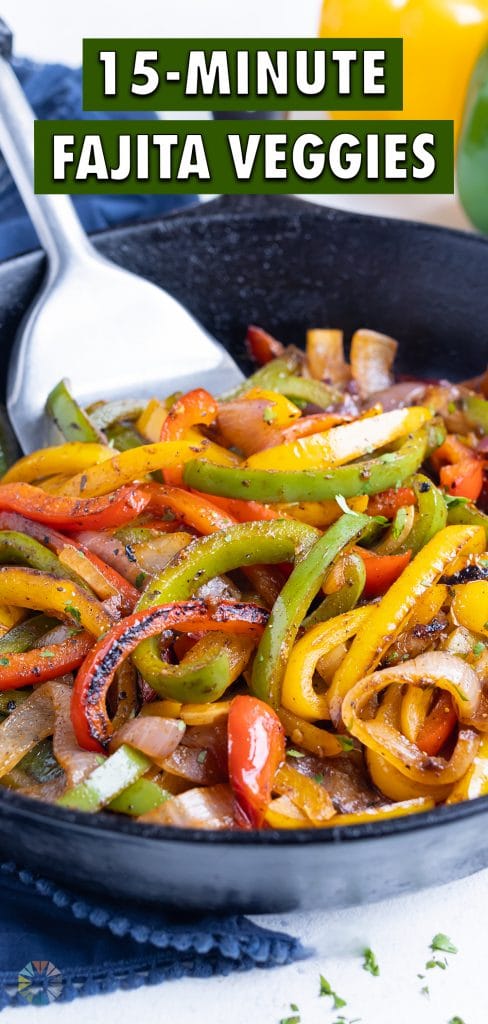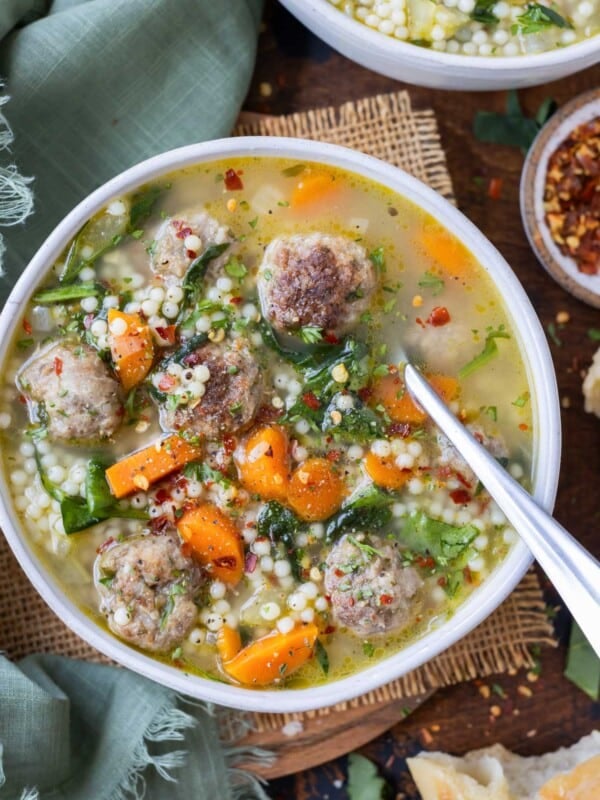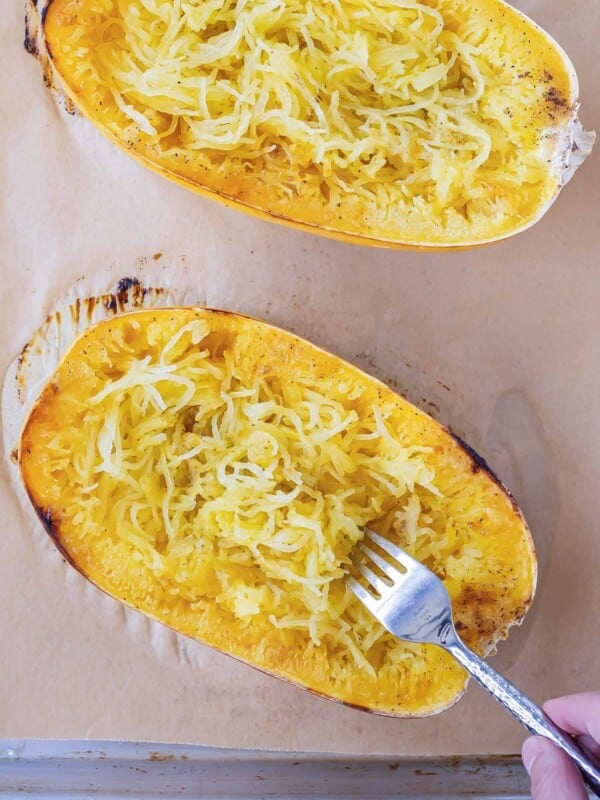There’s no need to leave the house, this quick and easy recipe tastes just like Chipotle Fajita Veggies—maybe even better?! The trick is to cook them in a cast-iron skillet for the perfect texture, season with a simple fajita seasoning mix (it’s not just for meat!), and cut the strips into the correct shape so everything cooks up evenly. You will love these veggies as much, if not more, than the meat they’re served with.
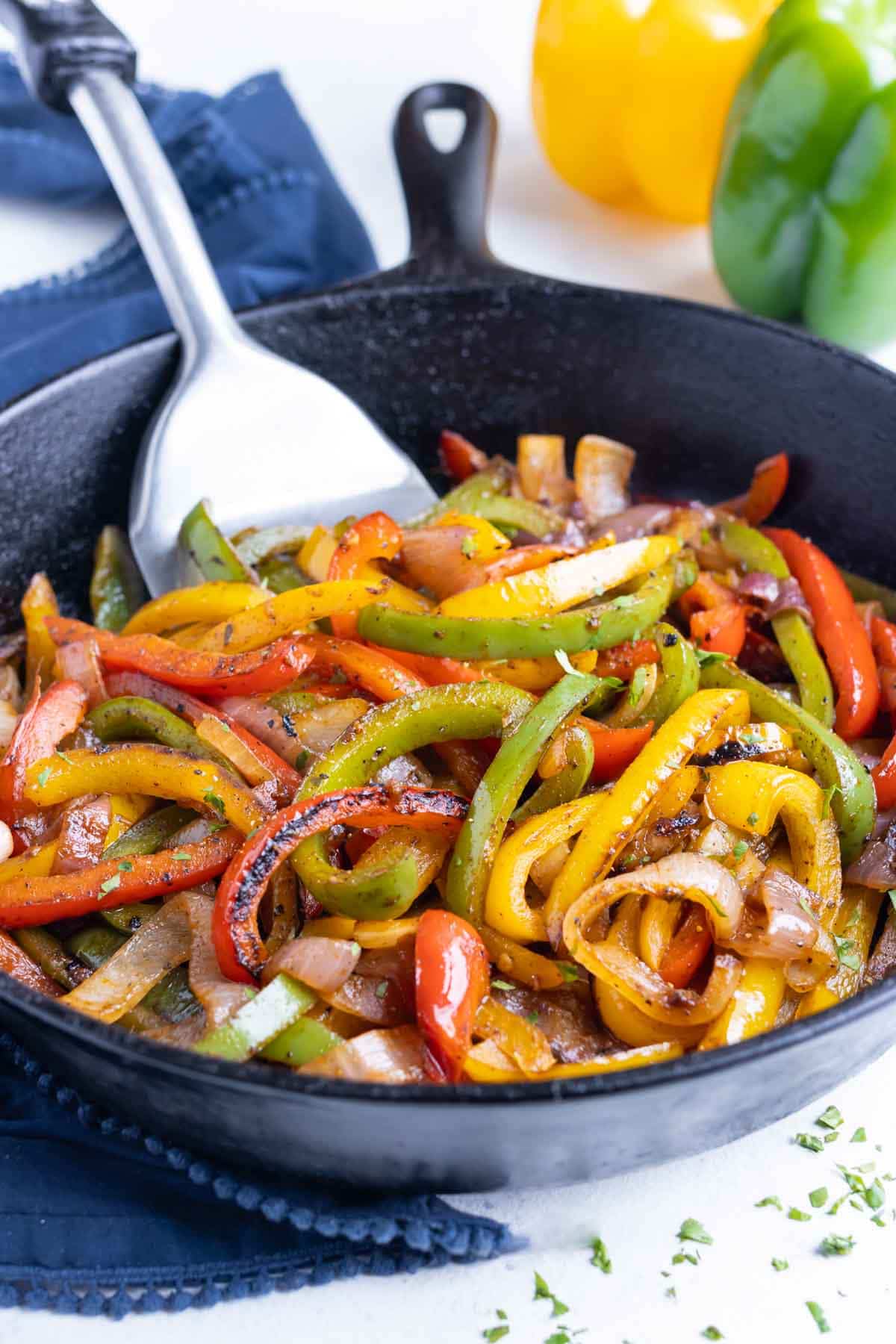
Fajita Veggies Recipe (Chipotle Copycat)
While most believe the meat is what makes a good taco, I would have to argue that no taco is complete without a heap of fajita veggies on top!
Thankfully, it turns out that this simple and delicious accompaniment is super easy to make at home.
The subtle sweetness of the peppers and onions comes through when they’re tossed in a homemade Mexican seasoning mix and sautéed in a skillet until a gorgeous, crusty char forms.
They’re so full of flavor that you can even skip the meat entirely, and go vegetarian or vegan with dinner!
And if you’re a fan of Chipotle Mexican Grill, then you’re in luck. Because these delicious fajita veggies taste just as good, if not better than the restaurant version side dish! Once you make this copycat Chipotle fajita veggies recipe, there’s no going back.
Want to try other copycat recipes? Give these Chipotle Burrito Bowl, Chipotle Corn Salsa, Cilantro Lime Rice, and Chipotle Chicken recipes a go. And don’t miss these air fryer roasted red peppers!
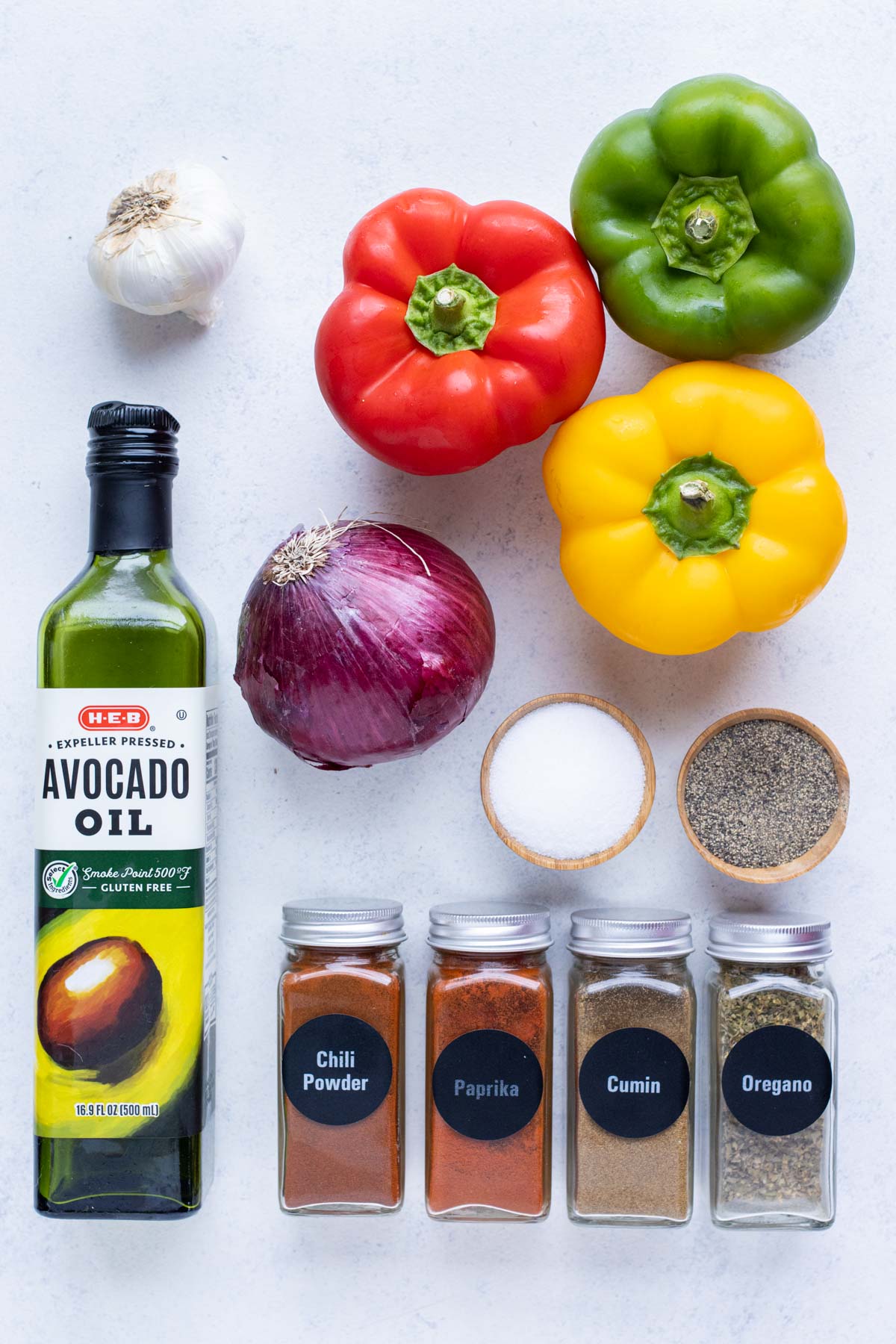
Ingredients
- Bell peppers. Using a mix of red, yellow, and green peppers creates a beautiful effect and gives a slightly more complex flavor. But you can go with all one color, if preferred.
- Onion. Choose a red onion for its strong, pungent flavor. However, you can sub a sweet or white onion.
- Oil. A neutral cooking oil with a high smoke point, such as avocado oil, is ideal. If it’s all that’s available, vegetable or olive oil will also do.
- Garlic. Fresh garlic is preferred, however for each clove, ⅛-teaspoon of garlic powder may be substituted.
- Fajita Seasoning. A homemade mix of spices typical in Mexican cuisine, including chili powder, paprika, cumin, oregano, salt, and pepper.
Note: For more information on preparing these ingredients at home, see How to Cut an Onion and How to Mince Garlic.
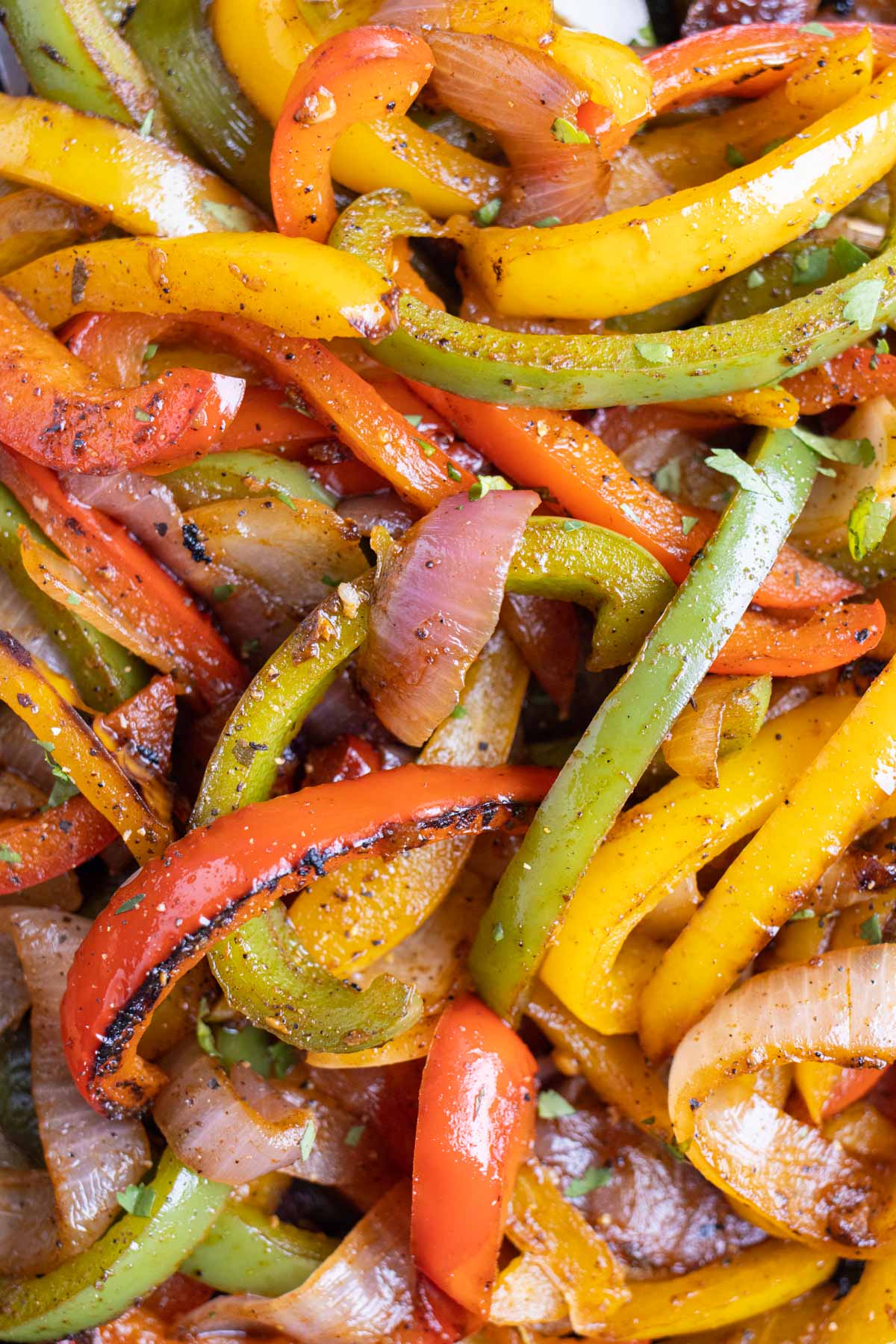
How to Make Fajita Veggies
Please see the recipe card below for more detailed ingredient amounts.
1. Slice Peppers
Using a sharp chef’s knife, cut from the top to the bottom next to the core of the pepper. Repeat until only the core remains. Discard the core, and repeat with the remaining peppers.
Trim away any lingering pieces of white membrane attached to the pieces of bell pepper flesh. Thinly slice the remaining pepper sections into ¼-inch thick strips.
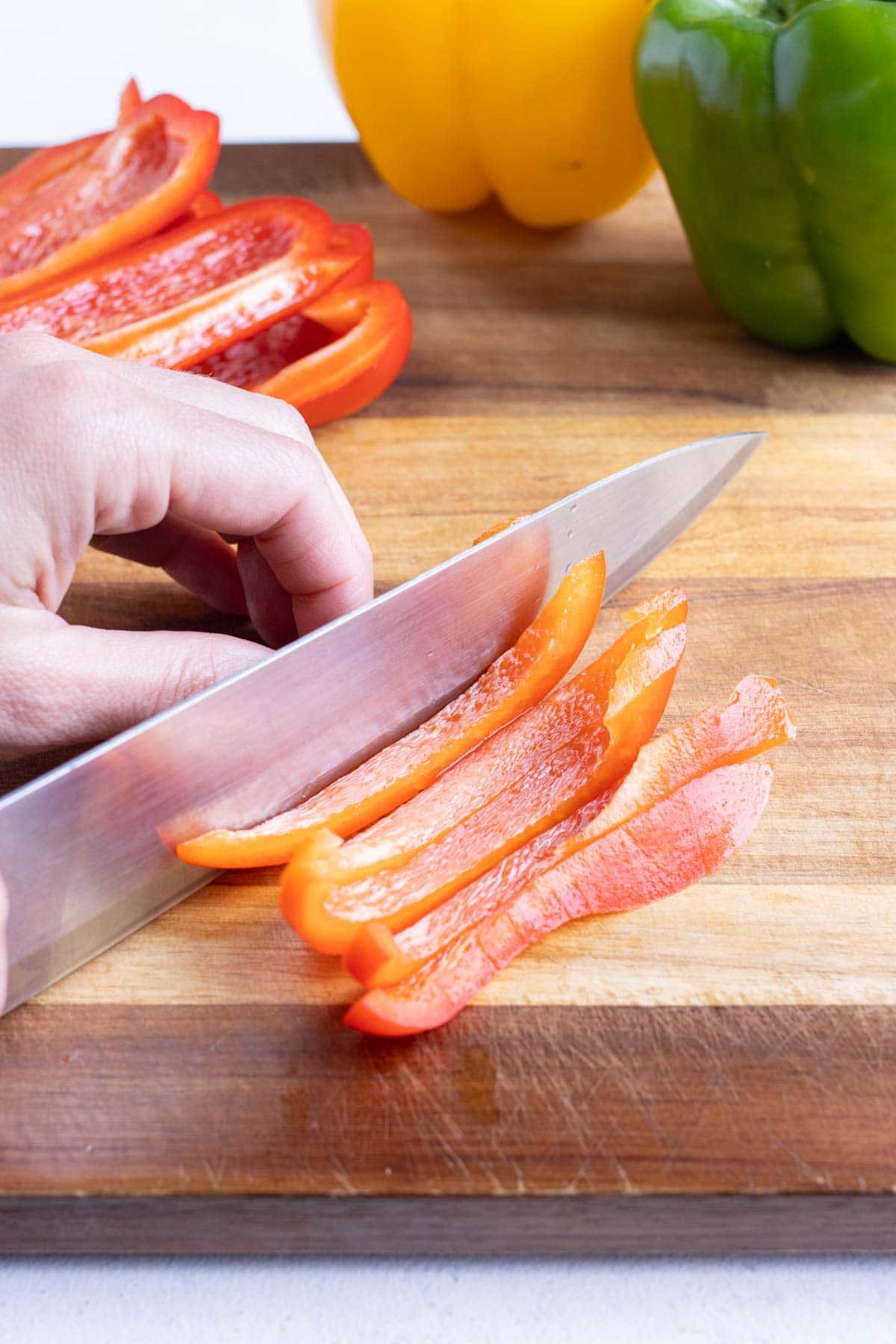
2. Cut Onions
Before cutting, peel away as many layers of the thin, papery skin as possible from the onion by hand. Use a sharp knife to cut about ½- to 1-inch from the top and bottom of the onion.
Make a shallow incision into the thin outer layer of the onion, and peel that piece away as well. Place the onion flat-side down on the cutting board and slice it in half through the top, cutting through the core.
Lay each half, cut-side down, onto the board and thinly slice them lengthwise into ¼-inch thick strips. You should end up with pieces roughly the same size as the sliced peppers.
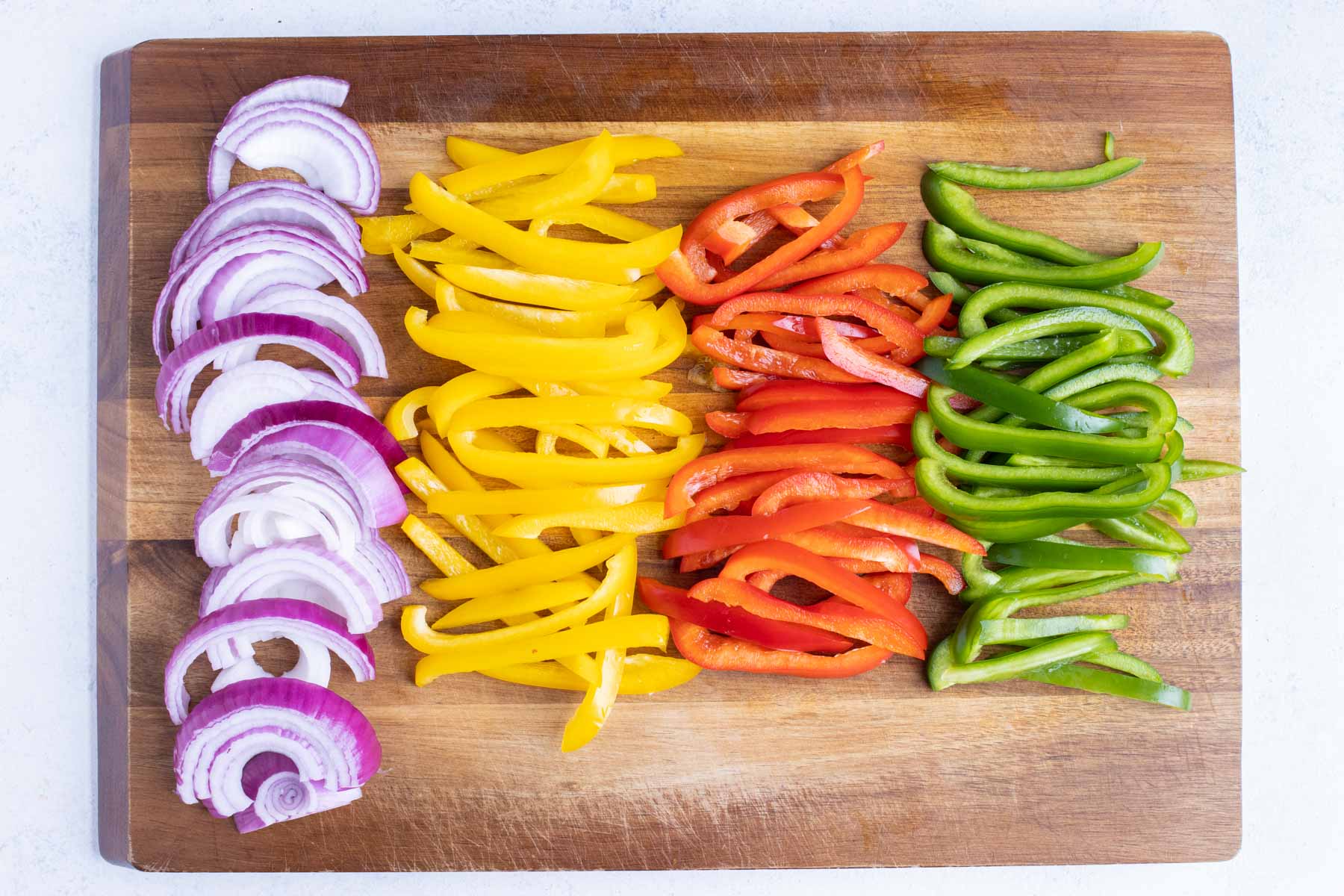
3. Cook in Cast-Iron Skillet
Pour your oil into a large cast-iron pan heated on medium-high. When warm, add the garlic, and sauté it for 30-60 seconds, or until it becomes fragrant and begins to brown. Watch it carefully, as it can burn very easily. (If needed, reduce to medium heat.)
Add the thin strips of bell peppers, sliced large red onion, and homemade Fajita Seasoning, mixing to combine them. Cook over medium-high heat for 7-8 minutes, stirring occasionally to ensure even cooking.
For the best results and a little more of a charred effect, let the colorful vegetables sit for a minute or two between stirring. Charring helps to caramelize the natural sugars inside the vegetables, enhancing their flavors.
Keep a close eye on them, however, as they can very quickly go from charred to burned in the large cast-iron skillet!
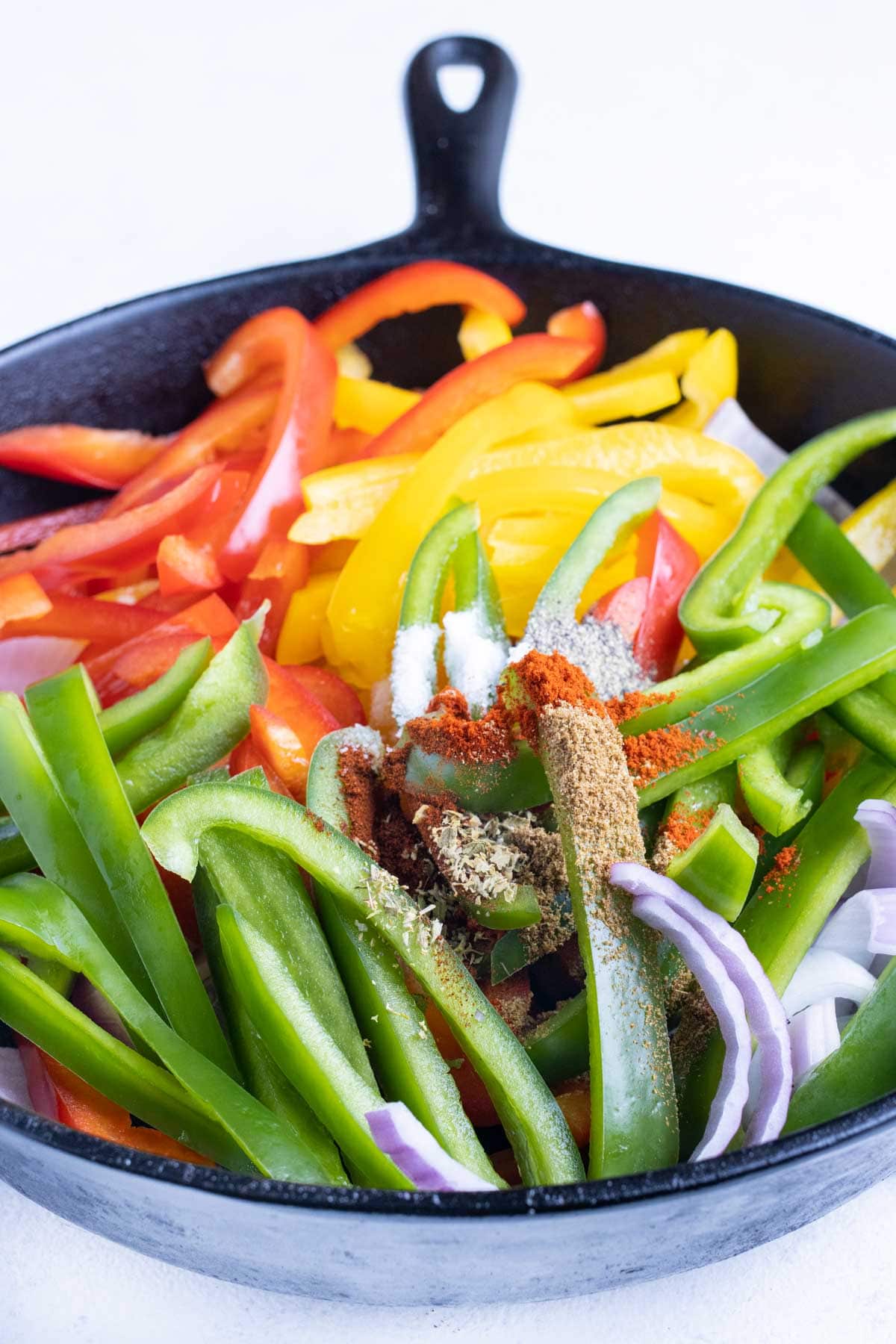
4. Stir and Serve
When the vegetables are finished cooking, sample a few pieces and adjust the seasoning level to taste, if needed.
Remove the skillet from the heat and stir the vegetables very well, trying to get up any browned bits clinging to the pan.
Serve the fajita vegetables immediately. They can be enjoyed on their own or in a variety of dishes. Use these delicious sautéed peppers and onions with vibrant color as a topping for tacos, burrito rice bowls, veggie fajita salads, nachos, or even on a burger or sandwich!
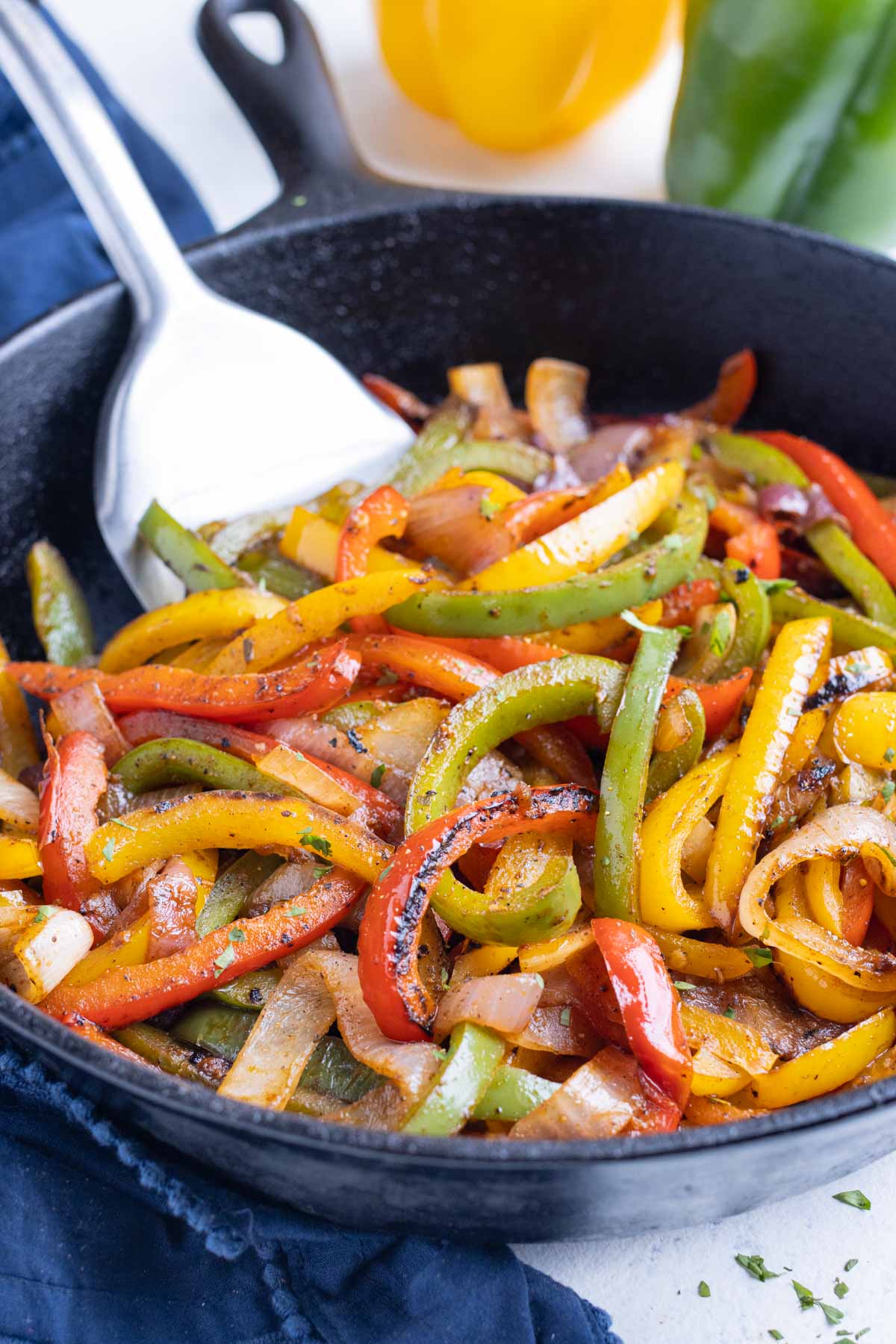
FAQs
Fajitas are traditionally served on flour or corn tortillas with sliced chicken or beef, peppers, and onions. They can include any preferred toppings such as rice, black beans, cheese, sour cream, corn, pico de gallo, cilantro, lime juice, and more!
The peppers in fajitas can be substituted with any other preferred option such as zucchini, eggplant, or portobello mushrooms. Keep in mind that this may affect cooking times, which you should adjust accordingly.
Fajitas are generally defined by the presence of grilled or sautéed vegetables like peppers and onions, whereas tacos are most often served with finely chopped raw ingredients. The two concepts may be combined, however, as fajita vegetables make for an excellent topping on tacos!
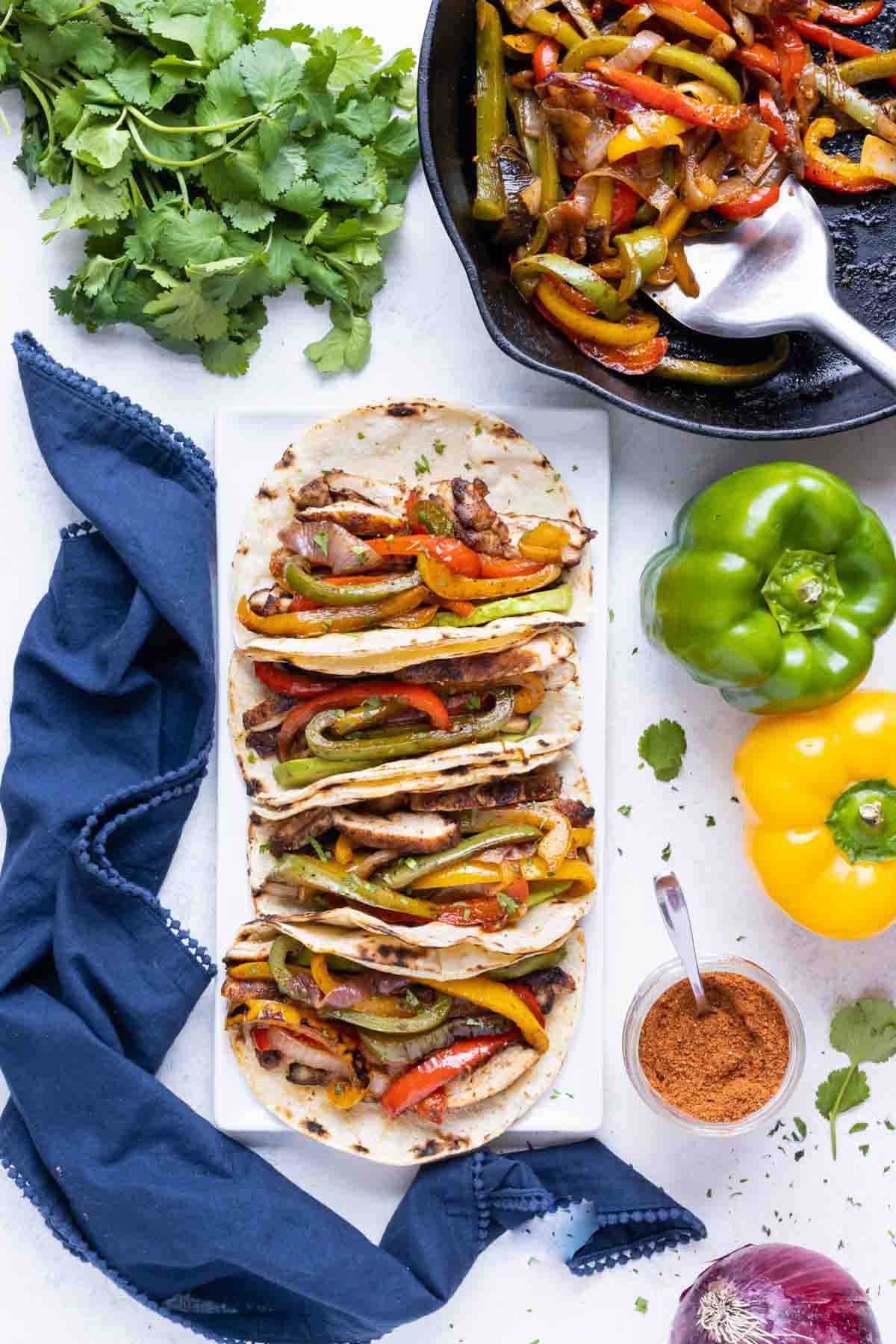
What to Serve with Fajita Veggies?
These veggies taste amazing on their own, but are best enjoyed alongside some of these classic sides and entrées:
- Best Steak Fajitas
- Fiesta Lime Chicken
- Paleo Cassava Flour Tortillas
- Cilantro Lime Rice
- Mexican Rice
- Easy Homemade Guacamole
- Fresh Tomato Salsa
More Easy Mexican Dinner Recipes
A weeknight Mexican dinner doesn’t always have to be difficult or unhealthy. Here are even more wholesome, homemade recipes like this one:
- Mexican Stuffed Bell Peppers
- Air Fryer Fish Tacos
- Mexican Zucchini Taco Boats
- Chicken Tinga Tostadas
- Mexican Shrimp Ceviche with Avocado
- Easy Shredded Chicken Tacos
Tap stars to rate!
Fajita Veggies Recipe (Chipotle Copycat)
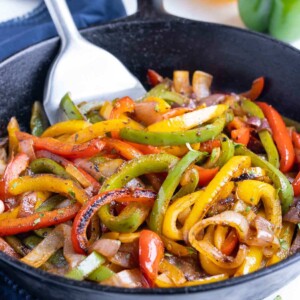
email this recipe!
Ingredients
- 3 bell peppers red, yellow, and green
- 1 red onion white or sweet
- 2 Tbsp. oil avocado or olive
- 2 cloves garlic finely minced
- ½ tsp. chili powder
- ½ tsp. paprika
- ½ tsp. cumin
- ¼ tsp. oregano
- 1 tsp. salt to taste
- ¼ tsp. pepper to taste
Instructions
- Cut the Veggies: Thinly slice the bell pepper and cut the onion into thin slices.*3 bell peppers, 1 red onion
- Heat the Garlic: Add the oil to a cast iron skillet over medium-high heat along with the garlic. Sauté for 30-60 seconds, or until the garlic becomes fragrant and begins to brown.2 Tbsp. oil, 2 cloves garlic
- Sauté the Veggies: Add sliced peppers, onions, and seasonings. Cook over medium-high heat for 7-8 minutes, stirring occasionally. For more of a char, let the veggies sit for a minute or two before stirring. Pay close attention, however, because they can burn quickly!½ tsp. chili powder, ½ tsp. paprika, ½ tsp. cumin, ¼ tsp. oregano, 1 tsp. salt, ¼ tsp. pepper
- Serve the fajita veggies immediately on tacos, in a burrito bowl, or on their own and enjoy!
Tap stars to rate!
Video
Notes
- How to Slice Bell Peppers: Find a bulbous part of the bell pepper and cut this off. Locate the white membrane and continue cutting off the bell pepper flesh while keeping the white part attached to the seeds. You should end up with 4-5 pieces of bell pepper and the core with the seeds and membranes still attached. Repeat this with the remaining peppers. Trim and remove any white membranes, or pith, from the bell pepper flesh. Thinly slice into ¼-inch thick pieces.
- How to Slice Onions: Cut and remove ½-1 inch from both ends of the onion. Make a shallow incision into the outer layer and then peel it off. Place the onion flat-side down onto the cutting board and slice it in half. Put the onion half cut-side down onto the board and cut it lengthwise into ¼-inch thick slices. Repeat this with the other half of the onion.
- Experiment with ingredients. Trying out different vegetable combinations for your fajita mix is a great way to explore new flavors. Eggplant, mushrooms, squash, and zucchini all make great additions.
- Go for cast-iron. Using a cast-iron skillet is ideal for this recipe because it can retain the high heat needed for charring.
- Get colorful… or not. Using multiple types of bell pepper is a great way to add color contrast to your fajitas, but not necessary.
- Add a little spice. For an extra kick of heat, try including a hotter variety of peppers such as jalapeños or poblanos.
- Let them sit. Allowing the fajita vegetables to char a bit in the pan caramelizes the natural sugars in them, enhancing their flavor.
Nutrition
Nutrition information is automatically calculated, so should only be used as an approximation.

